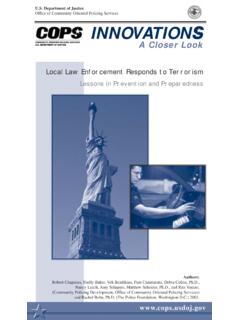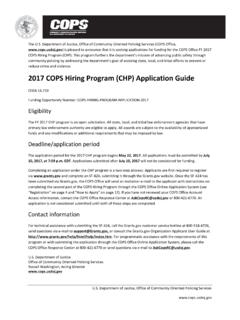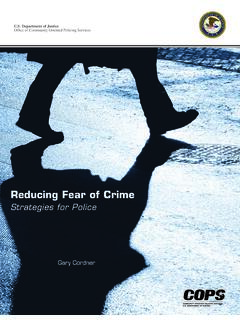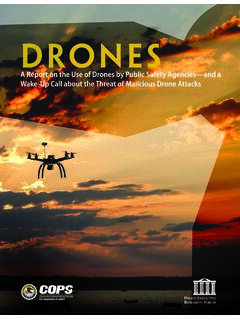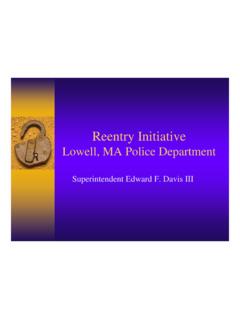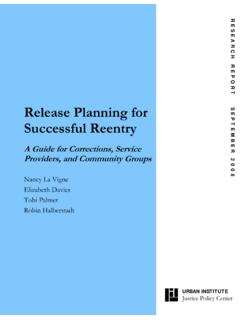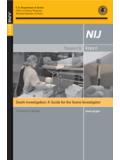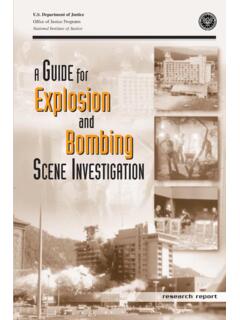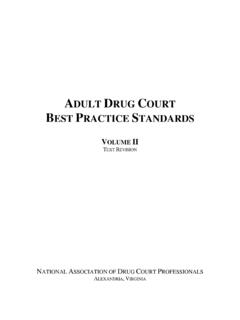Transcription of AWARD-WINNING COMMUNITY POLICING STRATEGIES
1 1999 2006. AWARD-WINNING . COMMUNITY POLICING STRATEGIES . A REPORT FOR THE. INTERNATIONAL ASSOCIATION OF CHIEFS OF POLICE. COMMUNITY POLICING COMMITTEE. CARLOS FIELDS. Department of justice , COPS office 1. ABOUT THE IACP. The International Association of the Chiefs of Police ( ) is the world's oldest and largest nonprofit membership organization of police executives, with more than 20,000 members in more than 100. different countries. IACP's leadership consists of the operating chief executives of international, federal, state, and local agencies of all sizes. ABOUT THE IACP COMMUNITY POLICING COMMITTEE. Following the COMMUNITY - POLICING philosophy of collaborative problem solving, the Committee has a diverse membership. Members include chiefs of police services of various sizes, academics, the private sector and corrections officials, all of whom are committed strongly to the goals of COMMUNITY POLICING . ABOUT THE office OF COMMUNITY ORIENTED POLICING SERVICES.
2 The COPS office was established as a result of the Violent Crime Control and Law Enforcement Act of . 1994 to assist law enforcement agencies in enhancing public safety through the implementation of COMMUNITY POLICING STRATEGIES in jurisdictions of all sizes across the country. COPS provides funding to state, local, and tribal law enforcement agencies and other public and private entities to train COMMUNITY POLICING professionals, acquire and deploy cutting-edge crime-fighting technologies, and develop and test innovative POLICING STRATEGIES . This broad range of programs helps COPS offer agencies support in virtually every aspect of law enforcement, and it's making America safer, one neighborhood at a time. To learn more information about COMMUNITY POLICING STRATEGIES such as those discussed in this report please visit COPS Online at LETTER FROM THE DIRECTOR OF COPS. Since 1995, the Department of justice office of COMMUNITY Oriented POLICING Services (COPS) has worked diligently to advance the manner in which COMMUNITY POLICING is practiced at the state and local level throughout the nation.
3 COPS has invested $ billion in support of this objective, including grants awarded to more than 13,000 state and local law enforcement agencies, training more than 500,000 law enforcement officers and local leaders, and by funding the development of numerous technical assistance resources that seek to increase the body of knowledge available on critical COMMUNITY POLICING issues. This report offers a brief description of approaches that have been successfully developed and implemented at the local level to reduce crime and disorder. We are confident that many of the strategic principles documented in the report can be modified as needed and adopted by other law enforcement agencies in support of their efforts to develop and implement COMMUNITY POLICING programs that address challenges they may be confronting. Moreover, the jurisdictions that implemented the approaches detailed in this report should be commended for their innovativeness and commitment to COMMUNITY POLICING .
4 Undergoing the level of organizational change iii that is required to shift operational and strategic approaches to proactively fighting crime and disorder can be among the most significant challenges to successfully implementing comprehensive COMMUNITY POLICING solutions. It is no small feat. However, I'm certain that the law enforcement, local government, and COMMUNITY leaders from the jurisdictions referenced in this report would attest to the benefits of working smarter to fight crime through COMMUNITY POLICING . The COPS office is grateful to the International Association of Chiefs of Police and the IACP COMMUNITY POLICING Committee for their ongoing leadership within the field, and for supporting the good work represented within this report. Over the years, their expertise has been a significant contributor to effective COMMUNITY POLICING , and they have been instrumental in furthering the mission of the COPS office . Congratulations to the COMMUNITY POLICING Award winners and finalists, and thank you again for your commitment to fighting crime and disorder through effective COMMUNITY POLICING approaches.
5 Carl R. Peed Director office of COMMUNITY Oriented POLICING Services Department of justice iv LETTER FROM THE CHAIR OF THE IACP COMMUNITY POLICING COMMITTEE. The COMMUNITY POLICING Committee of the International Association of Chiefs of Police comprises a dedicated group of police and COMMUNITY professionals who are passionate about COMMUNITY POLICING and its ability to build partnerships, solve problems, and improve quality of life. The call of the Committee is to promote the philosophy of COMMUNITY POLICING , with its emphasis on initiative, ingenuity, and innovative approaches, among the 20,000 members of the IACP. This is done through various means, including: reviewing and distributing COMMUNITY oriented POLICING literature, training and research materials; compiling a network of professional law enforcement and academic experts on COMMUNITY POLICING ;. establishing links with public and private sector agencies to enhance communication, training and mutual problem solving; and by identifying, rewarding and portraying as models, agencies that have successfully implemented the COMMUNITY POLICING philosophy.
6 One of the main Committee activities for the past 10 years has been to identify and reward the best practices in COMMUNITY POLICING around the world. To that end, in 1998, the COMMUNITY POLICING Committee and its former partner, ITT Night Vision, developed the COMMUNITY POLICING Award to recognize outstanding COMMUNITY POLICING initiatives by law enforcement agencies worldwide. Since that time, the Committee has reviewed . thousands of submissions from communities and agencies all over the world and recognized those that use the power of partnership to make our local, national, and global communities safer from crime and terrorism. This work is a compilation of the best practices of the more than 50 winners and 150 finalists of the COMMUNITY POLICING Award. These best practices cover everything from traffic, gang, and drug problems to homeland security issues. They provide a viable framework for the delivery of improved police services that focus limited resources on issues specific to individual communities, and are also pertinent to all communities around the world.
7 Chief Todd Miller Terrell (Texas) Police Services Committee Chairman CONTENT. About the IACP .. i About the IACP COMMUNITY POLICING Committee .. i About the office of COMMUNITY Oriented POLICING Services .. i Letter from the Director of iii Letter from the Chair of the IACP COMMUNITY POLICING Committee .. v Introduction .. 1. Summary of Findings .. 3. Summary of Award Winners and Finalists .. 5. COMMUNITY POLICING Strategy Categories and STRATEGIES .. 9. Problem Solving and Prevention .. 10. COMMUNITY Engagement .. 11. COMMUNITY Assessment and Engagement .. 12. Educate the COMMUNITY .. 13. Educating the Private Sector .. 14. Partnerships .. 15. Partnership with the COMMUNITY .. 15. vii Partnership with Non-Profit Organizations .. 17. Partnership with Other Public Sector Agencies .. 17. Partnerships with the Private Sector .. 18. Task Forces .. 19. Organizational Development and Change .. 21. Program and Resource Development .. 21. Training and Cross-Training.
8 22. Strategic Planning .. 23. Use of Civilian Volunteers .. 23. Align Officer Performance Measures .. 24. Leadership and Risk Taking .. 25. Organizational 26. Analysis, Measurement and 28. COMMUNITY POLICING STRATEGIES by Region .. 31. West Region .. 31. Southwest Region .. 32. Midwest Region .. 33. Southeast Region .. 34. Northeast Region .. 30. International Region .. 36. List of Award Winners and Finalists .. 37. viii INTRODUCTION. Since 1998, the IACP COMMUNITY POLICING Committee has presented the annual COMMUNITY POLICING Award to recognize the efforts of police departments in advancing COMMUNITY POLICING . This year, the members of the committee chose to highlight some of the most innovative approaches used by police departments from 1999 2006. After reviewing the profiles of 103 United States and International IACP COMMUNITY POLICING award winners and finalists, a number of COMMUNITY - POLICING STRATEGIES were identified as constructive elements in advancing local COMMUNITY POLICING efforts in these agencies.
9 This report organizes each strategy into one of five major COMMUNITY POLICING strategy categories, and provides a brief description of each of the major COMMUNITY POLICING strategy categories and individual STRATEGIES , as well as several examples of how some . One hundred-three award winners and finalists IACP COMMUNITY POLICING Award winners and finalists utilized the strategy in their profile were analyzed for COMMUNITY POLICING efforts. Finally, graphs and charts illustrate the use of each this report. To avoid using repeat submissions, only COMMUNITY POLICING strategy by category and by region. This purpose of this report is to highlight the noteworthy work of the IACP COMMUNITY 97 profiles are included in this report.. Departments also . POLICING Award winners and finalists, as well as to inform law enforcement executives combined individual STRATEGIES into and others about innovative means to advance COMMUNITY POLICING and ensure safer comprehensive efforts.
10 Communities for their residents. SUMMARY OF FINDINGS. The results of the review of the 103 winners and finalists from 1996 to 2006 (see Figure 1) found the following: An overwhelming majority of departments included in this report combined multiple STRATEGIES for a comprehensive COMMUNITY POLICING approach. Resource and program development was the most frequent COMMUNITY POLICING strategy employed by the winners and finalists of the IACP COMMUNITY POLICING Award. Local police departments partnered with a variety of organizations and in the private and nonprofit sectors: including hospitals, mental health professionals, and local business owners. Other police departments partnered with public sector entities, . The award winners and such as social service agencies, local legislators, and others.. finalists used the words collaboration and partnerships . The majority of the departments included in this report used some type or form of analysis, measurement, or evaluation to support their local COMMUNITY POLICING efforts.
